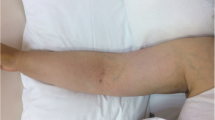Abstract
Recent studies have demonstrated an increased incidence in the diagnosis of malignancy subsequent to the diagnosis of deep venous thrombosis or pulmonary embolus. We reviewed 237 patients with venographically proven deep venous thrombosis over eight years. Of these, 216 had at least one predisposing cause for deep venous thrombosis; of the remaining 21 patients, three had hemoglobin determinations revealing anemia and were subsequently shown to have a malignant disease. One patient had two chief complaints and was shown to have deep venous thrombosis and malignant disease. The 17 remaining patients underwent computed tomographic scan of the abdomen and seven (41%) had abnormalities which proved to be malignant in origin. One further patient was diagnosed with carcinoma of the cervix two months following the onset of deep venous thrombosis. The remaining 10 patients continued free of malignant disease. Five have died of circulatory causes in the follow-up period. Seven of the nine patients diagnosed with malignancy succumbed within six months of the diagnosis. We conclude that only a small group of patients with deep venous thrombosis will have no identifiable cause for deep venous thrombosis and be asymptomatic for malignancy. Complete blood count, physical examination and computed tomographic scan of the abdomen at the time of venographic diagnosis of deep venous thrombosis is useful in diagnosis of “occult” malignancy. The number of gynecologic tumors would suggest the need for pelvic examination as well as radiographic examination. The presence of deep venous thrombosis and malignant disease is an ominous prognostic sign.
Similar content being viewed by others
References
GORE JM, APPLEBAUM JS, GREENE HL, et al. Occult cancer in patients with acute pulmonary embolism.Ann Intern Med 1982;96:556–560.
GOLDBERG RJ, SENEFF M, GORE JM, et al. Occult malignant neoplasm in patients with deep venous thrombosis.Arch Intern Med 1987;147:251–253.
GOLDHABER SZ, BURING JE, HENNEKENS CH. Cancer and venous thromboembolism.Arch Intern Med 1987;147:216.
TROUSSEAU A. Lectures on clinical medicine delivered at the Hotel Dieu, Paris, London: The New Sydenham Society: 1872:282–332.
PINEO GF, BRAIN MC, GALLUS AS, et al. Tumors, mucin production, and hypercoagulability.Ann NY Acad Sci 1974:230:262–270.
SACK GH Jr, LEVIN J, BELL WR. Trousseau's syndrome and other manifestations of chronic disseminated coagulopathy in patients with neoplasms: clinical, pathologic, and therapeutic features.Medicine (Baltimore) 1977;56:1–37.
SUN NC, MC AFEE WM, HUM GJ, et al. Hemostatic abnormalities in malignancy: a prospective study of one hundred eight patients. Part I coagulation studies.Am J Clin Pathol 1979;71:10–16.
SCHAFER AI. The hypercoagulable states.Ann Intern Med 1985;102:814–828.
RICKLES FR, EDWARDS RL. Activation of blood coagulation in cancer: Trousseau's syndrome revisited.Blood 1983;62: 14–31.
WEICK JK. Intravascular coagulation in cancer.Semin Oncol 1978;5:203–211.
SLICHTER SJ, HARPER LA. Hemostasis in malignancy.Ann NY Acad Sci 1974;230:252–261.
LIEBERMAN JS, BORRERO J, URDANETA E, et al. Thrombophlebitis and cancer.JAMA 1961;177:542–545.
GALLUS AS. Established venous thrombosis and pulmonary embolism.Clin Haematol 1981;10:583–611.
SHATTIL SJ. Diagnosis and treatment of recurrent venous thromboembolism.Med Clin North Am 1984;68:577–600.
NUSBACHER J. Migratory venous thrombosis and cancer: mechanisms and clinical manifestations.Prog Clin Cancer 1967;3:151–156.
EMERSON PA, MARKS P. Preventing thromboembolism after myocardial infarction: effect of low-dose heparin or smoking.Br Med J 1977;1:18–20.
FOGARTY TJ. Surgical management of acute vascular occlusion. In:COOPER P, NYHUS LM (eds).Surgery Annual. New York: Appleton-Century-Crofts, 1970:207–221.
Author information
Authors and Affiliations
About this article
Cite this article
Sannella, N.A., O'Connor, D.J. “Idiopathic” deep venous thrombosis: The value of routine abdominal and pelvic computed tomographic scanning. Annals of Vascular Surgery 5, 218–222 (1991). https://doi.org/10.1007/BF02329376
Issue Date:
DOI: https://doi.org/10.1007/BF02329376




